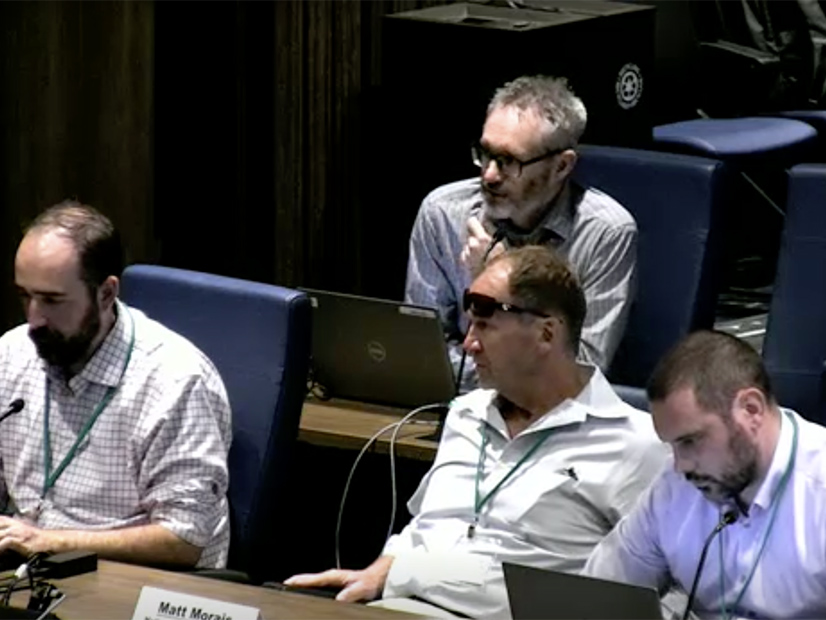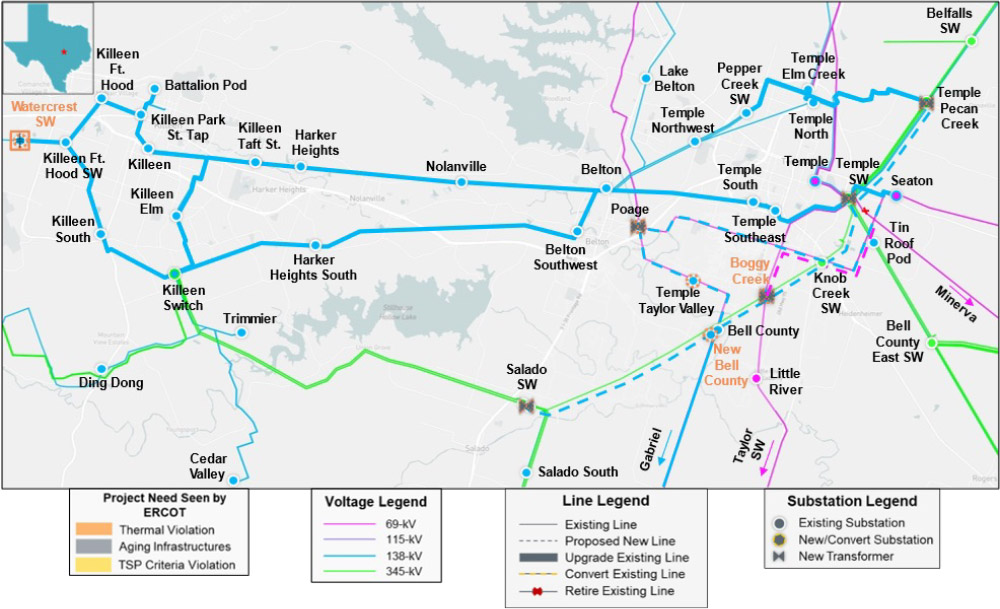
Staff Implement ECRS Changes, Withdraw Related NPRR
ERCOT staff have withdrawn a protocol change and updated control room procedures following the regulatory commission’s rejection of modifications to the grid operator’s new ERCOT contingency reserve service (ECRS) product.
The Public Utility Commission on June 25 rejected the nodal protocol revision request (NPRR1224) by removing the proposed $750/MWh price floor and directing ERCOT to separately implement the revision’s trigger mechanism for the service. (See Texas Commission Rejects ECRS Rule Change.)
“I think my lawyers would say that they did not direct us to do anything, but that they expressed some support for the concept of releasing ECRS when we hit the triggers that were described, so we’re going to roll with that,” ERCOT’s Jeff Billo, director of operations planning, told the Technical Advisory Committee during its July 31 meeting.
Staff and stakeholders had been working since late last year to reach a compromise on NPRR1224. Stakeholders added the price floor for ECRS’s deployment. The trigger mechanism takes effect when there is a 40-MW power balance violation for at least 10 minutes.
ERCOT introduced ECRS last year. It procures capacity resources that can be brought online within 10 minutes and sustained at a specified level for two consecutive hours. The Independent Market Monitor has opposed the new ancillary service, saying it produced “massive” inefficient market costs totaling more than $12 billion in 2023. (See ERCOT Board of Directors Briefs: Dec. 19, 2023.)
Billo said ERCOT has updated its real-time desk procedures to incorporate the trigger mechanism, which became effective Aug. 1.
The grid operator also withdrew NPRR1232, which staff had begun developing during the NPRR1224 negotiations. Billo said after the PUC’s discussion of NPRR1224’s price floor and stakeholders’ concerns over NPRR1232’s implementation and timeline, staff decided to withdraw the latter and its similar price floor concept.
Staff discussed NPRR1232’s withdrawal with the IMM, Billo said. He said he understood the monitor was “agreeable” with the withdrawal.
$29M in Firm Fuel Service
ERCOT staff told TAC it procured 3,319.9 MW of firm fuel supply service (FFSS) capacity with a projected standby cost of $29.88 million between Nov. 15, 2023, and March 15, 2024.
The grid operator contracted with 32 generation resources at $9,000/MW. Three of those either tripped offline during a watch or had mechanical failures unrelated to fuel or cold weather, leading ERCOT to claw back $976,818 from the resources. The clawback was offset partly by $781,342 in fuel replacement costs, resulting in a total FFSS payment of $29.42 million.
The FFSS ancillary service product is a result of legislative requirements and a PUC order to provide additional grid reliability and resiliency during extreme cold weather and compensate generation resources that meet a higher resiliency standard. Under ERCOT protocols, staff will provide a report to TAC when the product is deployed.
The ISO issued a request for proposal for FFSS during the next obligation period (Nov. 15, 2024-March 15, 2025) on July 31.
In other staff reports:
-
- Matt Mereness told TAC that ERCOT’s highly anticipated real-time co-optimization (RTC) and battery project expects to announce a go-live date by the end of September. The project’s tentative go-live date is 2026. In September, staff will simulate RTC, covering data from June 2023 onward, using their simulator for feedback on price formation.
-
- Bill Blevins, who chairs the Large Flexible Load Task Force, said more than 5 GW of load has been authorized and is waiting to be energized. The task force has discussed going into hibernation; members raised concerns over dissolving the group because they value the interconnection queue updates.
$272.6M Project Endorsed
TAC endorsed a $272.6 million regional project in Central Texas by adding it to the combination ballot. The Tier 1 project, requiring board approval, would address thermal violations in the Temple and Killeen area between Austin and Waco.
ERCOT staff said the Oncor Temple Area Regional Planning Group Project improves long-term load-serving capability, is the least-cost solution and requires the least amount of a certificate of convenience and necessity for the options that meet all ISO and NERC reliability criteria.
Oncor originally proposed a smaller project, but ERCOT staff’s study found additional thermal and voltage violations and recommended the alternative project after analyzing 11 options. The price tag more than doubles Oncor’s $120.7 million projection.
The project involves converting 69-kV circuits to 138 kV, upgrading more than 65 miles of 138-kV lines, removing existing 138-kV circuits from 345-kV structures, and building a new substation.
Error Forces NPRR’s Withdrawal
ERCOT staff told the committee it has pulled back an NPRR previously approved by TAC over an error in the protocol language that needs to be resolved before it can go to the board.
NPRR1215 clarifies that the day-ahead market energy-only offer credit exposure calculation zeros out negative values. However, ERCOT’s Austin Rosel said an error introduced an unintended change in the E2 credit formula by adding a price variable that wasn’t part of the original system design. Comments will be filed to address the error.
“We think this is the best way to get it back to get it corrected,” Rosel said.
TAC approved the change in June. It originally was scheduled to go before the board in August but will now have to wait until October.
Changes to CDR’s Methodology
Members approved two NPRRs in separate votes. NPRR1219 passed 21-2 with four abstentions; TAC’s consumer segment provided both dissenting votes and both abstentions. It proposes changing the methodologies for the capacity, demand and reserves (CDR) report’s preparation and incorporates a report release schedule. The NPRR also includes new definitions to support the methodology changes and revisions to address outdated terms and add clarity to the methodology descriptions.
Members raised concerns about using effective load-carrying capability (ELCC) for renewable resources and a rushed process and potential implications of changing the reporting methodology. They warned of confusion over differences in the CDR’s reliability metrics and ERCOT’s new reliability standard being developed.
TAC endorsed NPRR1230 23-2, with four abstentions. The four-person cooperative segment cast a dissenting vote and three abstentions over the proposal to establish a shadow price cap for congestion affecting interconnection reliability operating limits.
Members supported the measure because of its market-based approach and operational efficiency. It proposes to manage transmission flows with market mechanisms, rather than manual control room interventions. Cooperatives raised concerns about increased cost to load.
The combo ballot included three other NPRRs, another binding document request and a change to the Verifiable Cost Manual that, if approved by ERCOT’s Board of Directors as required, would:
-
- NPRR1217: Remove the requirement for load resources and emergency response service resources to be deployed with a verbal dispatch instruction (VDI) from ERCOT.
-
- NPRR1231: Provide more clarifications and improvements to the firm fuel supply service.
-
- NPRR1233: Add a flat fee for federally owned generation units and adjust the weatherization inspection fee for transmission service providers.
-
- OBDRR051: Align the methodology for implementing operating reserve demand curve to calculate real-time reserve price adder with system changes required for the emergency pricing program.
-
- VCMRR040: Remove the need for ERCOT to buy an annual coal price index subscription for use in calculating the quarterly coal fuel adder. The VCMRR describes a methodology for a qualified scheduling entity to submit “actual coal fuel adders” similar to the current process for natural gas resources.




